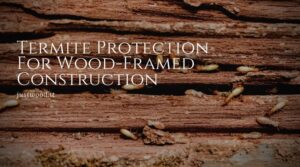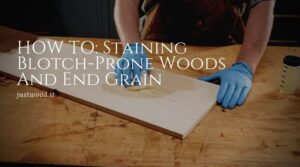This ‘How to’ describes how to achieve the best possible finish for your wooden surfaces. It shows how to prepare surfaces, how to color them using wood dyes and stains, and how to apply different types of varnish.
Table of Contents
Introduction
There are two key things to remember. The first is that good preparation is essential. Before you apply any finish, make sure that your wood is dry, clean, well sanded, and free from wax and grease.
The second thing to remember is that moisture will undo all your good work. To keep water out of your wood, you will need to apply finish to every surface with special attention paid to ends. If you’re working on an exterior door or window, seal any gaps between wood and masonry after you’ve applied the finish.
What you’ll need
Materials
- varnish,
- wood stain and dye
Tools & equipment
- Abrasive paper,
- Bucket and sponge,
- Cellulose thinner,
- Clean lint-free rag,
- Cork sanding block,
- Filling knife
- Scrapers,
- Varnish and wood stain brushes,
- White spirit,
- Wire wool ’00’ grade,
- Wood filler
Hint: Never use interior varnish in outdoor or exposed situations.
Safety first:
- Be sure to follow the manufacturer’s instructions for preparing and applying finishing products.
- Most varnishes and stains are flammable and toxic. Take the following precautions:
- Keep away from sources of ignition
- Don’t smoke
- Avoid contact with eyes
- Keep out of reach of children
- Used rags may self-ignite so keep outdoors in a metal container
- Wear rubber gloves or good barrier cream.
Preparing new wood

Clean the surface
Dust, grease, and wax will prevent wood stains and dyes penetrating, or varnishes adhering. Certain stains will need to be wiped over with white spirit or cellulose thinner before and after sanding.
Sand the wood
The key to success is a series of sanding stages. Work by hand or use a power sander. Always sand in the direction of the grain, using a progressively finer abrasive paper (fig. 1). Round off all sharp edges, especially on exterior timber as this is where your finish is most likely to break down.
Apply preservative
Apply two coats of clear preservative to all exterior timber. Interior woodwork that’s built-in or fixed will need one coat. There’s no need to apply a preservative to free-standing domestic furniture.
Preparing wood that’s already varnished

Do you need to strip the old varnish?
Before trying to recoat old varnish, test a small piece. If your new varnish causes the old varnish to lift or wrinkle, it’s best to strip the old varnish completely and start from scratch (fig. 2). If the surface remains sound, you can simply recoat.
Stripping old varnish

Be sure to use the correct stripper. Some paint strippers won’t remove varnish, and you’ll need a ‘hard varnish’ or ‘cellulose finish’ stripper for some interior sprayed varnishes.
Wash off all traces of stripper. Fill cracks, holes and open joints, color-matching your filler to the timber (fig. 3). If the stripper has bleached any areas, stain them to match the original color. Sand the surface carefully and remove all dust before varnishing.
Hint: To remove all dust, use your vacuum cleaner fitted with a brush or narrow nozzle (fig. 4).
Recoating old varnish
If the old varnish is sound, just clean the surface with water and detergent. Fill any gaps, color-matching your filler to the varnished surface. Rub smooth with fine ‘wet or dry’ paper.
Make sure that the wood is dry before you revarnish. Moisture can prevent good adhesion and cause a milky appearance. Wait for dry weather before varnishing exterior surfaces.
Applying preservative

Apply wood preservative only to bare, clean timber:
- New wood
- Wooden surfaces that have been completely stripped and cleaned, for example, window frames, exterior doors
- Previously preserved timbers, for example, constructional, garden timbers.
Brush liberally onto all surfaces of the timber until the wood is saturated. Pay special attention to end grain.
Exterior new wood and stripped wooden surfaces will need two coats of preservative. Interior new wood and timber that’s been preserved before needs one coat.
Allow 24 hours drying time between coats, and wait for 3–5 days before applying any other finish.
Colouring wood

Order of work
Dye, stain or varnish the sections of a paneled door in this order (fig. 5).
Colored polyurethane varnish
You can mix different colors of polyurethane varnish to get the shade you want.
Thin the first coat: 10 parts varnish to 1 part white spirit. Brush on to exterior or interior wood. Apply a second unthinned coat, then further coats until you have the finish you want.
Sand lightly between coats, using fine abrasive paper. Allow 6 hours of drying time between coats.
Colored varnish may produce an uneven coat on your timber. Apply a sealing coat of clear thinned varnish first. Allow to dry and sand lightly. Then apply further coats of the colored varnish until your surface is the color you want.
| # | Preview | Product | Rating | Price | |
|---|---|---|---|---|---|
| 1 |
|
SamaN Interior One Step Wood Seal, Stain and Varnish – Oil Based Odorless Dye... | $27.99 | Buy on Amazon | |
| 2 |
|
Minwax Helmsman Water Based Spar Urethane, Quart, Gloss | 7,930 Reviews | $25.98 | Buy on Amazon |
| 3 |
|
Rust-Oleum Varathane 225250H One-Step Wood Stain & Polyurethane, Quart, Dark... | $42.37 | Buy on Amazon | |
| 4 |
|
Minwax Water Based Oil-Modified Polyurethane, Warm Satin, Clear, 1 Gallon | $64.99 $50.00 | Buy on Amazon |
Wood dye
Before using a wood dye, test its effect and depth of color on your particular wood (exterior or interior). Dye an inconspicuous area on your surface, or an offcut of the same timber.
Use a folded lint-free cloth rather than a brush to apply the dye. Keep all working edges ‘wet’ to avoid a patchy or uneven surface. Wear plastic gloves to protect your hands.
When dry, rub (burnish) the surface with a dry, clean, lint-free cloth. This will remove any surplus dye and leave an even surface. Don’t sand, even lightly at this stage, as sanding tends to produce a streaky appearance.
The first very light sanding should be after the first diluted coat of varnish is fully dry. Slightly heavier sanding can be done after the second undiluted coat of varnish is fully dry.
See manufacturer’s instructions for drying times, and don’t mix dyes from different manufacturers.
| # | Preview | Product | Rating | Price | |
|---|---|---|---|---|---|
| 1 |
|
Wood Dye - Aniline Dye 5 Color Kit - Wood Stain Kit | 2,563 Reviews | $20.99 $19.50 | Buy on Amazon |
| 2 |
|
TransTint Dyes, Dark Walnut | $30.48 | Buy on Amazon | |
| 3 |
|
Vibrant Wood Dye Liquid Offered in 5 Color Liquid Dye Kit - Solvent Alcohol Dye | $60.99 | Buy on Amazon |
Stripped timber
You may find that the surface of stripped timber becomes rather patchy after it’s dyed. This problem is caused by the old finish that’s left in the grain.
It’s often better, therefore, to use colored varnish to change the color of stripped timber. Use clear varnish for the first coat, followed by the number of coats required, rubbing down between each coat.
Woodstain
Don’t:
- Stir or thin wood stains before using
- Use over varnish, paint or linseed oil putty
- Apply in temperatures below 5°C
For best results use varnish and wood stain brush, made especially for use with wood care products. Brush on evenly, avoiding over-spreading.
Coat all surfaces to provide total protection. Pay special attention to the treatment of tops and bottoms of doors, undersides of sills, sashes and end grain.
The original color and porosity of your wood will influence the final color of your surface after staining.
Previously stained wood needs one coat and bare wood need two coats. Allow 16–24 hours drying time.
| # | Preview | Product | Rating | Price | |
|---|---|---|---|---|---|
| 1 |
|
Varathane Less Mess Wood Stain and Applicator, 4 oz, Dark Walnut, (Pack of 1) | $9.99 $8.98 | Buy on Amazon | |
| 2 |
|
Varathane 262025 Varathane-262025 Premium Fast Dry Wood Stain, Half Pint, Dark... | 8,445 Reviews | $9.99 $8.47 | Buy on Amazon |
| 3 |
|
1/2 pt Minwax 22240 Special Walnut Wood Finish Oil-Based Wood Stain | 8,008 Reviews | $25.16 $7.47 | Buy on Amazon |
| 4 |
|
Furniture Clinic Wood Stain | Multiple Finishes | Fast Drying | Indoor and... | $11.95 | Buy on Amazon |
Previously stained wood
On previously stained wood, treat bare or bleached areas with wood dye and allow to dry. Touch in these areas with exterior wood stain and allow it to dry. Lightly rub down before applying a complete top coat.
Refinishing wood stains
Wood stains deteriorate over a period of 2–4 years, depending on the severity of the weather, and they can become very dirty.
To refinish your surface, first wash it down, ensuring you remove all grease. Allow the surface to dry and apply a coat of wood stain. If a second coat is needed, sand first coats lightly and dust off.
Applying clear varnish
Yacht varnish
Yacht varnish is generally used for exterior wood. Brush on, using the best brush you can afford, and rub down lightly between coats. Thin the first coat: 5 parts varnish to 1 part white spirit. Apply 3–4 further unthinned coats allowing varnish to dry thoroughly between coats.
Take care to treat the timber all round, especially the end grain. This prevents water from penetrating behind the varnished surface.
Clear polyurethane varnish
Polyurethane varnish can be used inside and out.
Thin the first coat: 10 parts varnish to 1 part white spirit and brush on. When dry, rub down with fine abrasive paper, then apply a second unthinned coat. Apply further coats until you have the finish you want. Allow 6 hours of drying time between coats.
Acrylic varnish
Apply liberally across the grain with a clean brush. To finish off, draw the brush lightly in the direction of the grain. Allow three coats for maximum durability.
The water content of the varnish may cause the first coat to raise the grain. If this happens, lightly sand the surface. You can use fine glass or garnet paper, but fine ‘wet or dry’ paper and water is best. Wash the sanded surface with clean water.
Apply acrylic varnish to the interior and exterior wood and to floors. Bare wood may be stained before varnishing.
| # | Preview | Product | Rating | Price | |
|---|---|---|---|---|---|
| 1 |
|
Liquitex Professional Gloss Varnish, 237ml (8-oz) | $23.29 $16.05 | Buy on Amazon | |
| 2 |
|
GRANOTONE Acrylic Artist's Varnish | Non-Yellowing | Non-Toxic | Anti-Crazing |... | 1,746 Reviews | $9.99 | Buy on Amazon |
| 3 |
|
Liquitex BASICS Gloss Varnish, 250ml (8.4oz) Bottle | $13.49 | Buy on Amazon | |
| 4 |
|
Krylon K01303007 Acrylic Spray Paint Crystal Clear Aerosol, Gloss Large Can, 11... | $13.05 | Buy on Amazon |
Cleaning brushes
If you’ve used:
- Wood dye clean with white spirit or methylated spirit
- Woodstain clean with white spirit or cellulose thinner
- Preservative, yacht varnish, polyurethane varnish clean with white spirit
- Acrylic varnish clean with water – if the brush has hardened, soften with cellulose thinner.
After cleaning with solvent, wash all brushes with detergent and warm water, rinse thoroughly in cold water, and dry carefully.





